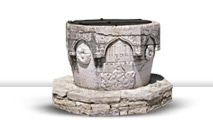
- Sečovlje Salt Pans - Dragonja River Valley
- Sv. Peter - Nova vas - Padna
- Pomjan - Nature Park: Karst Edge - Socerb
- Črni Kal - Osp - Kubed
- Momjan - Grožnjan - Pietrapelosa - Mirna
- Baštija - Kostanjica - Parenzana
- Oprtalj - Završje - Livade - Zrenj
- Istarske toplice - Motovun Forest - Višnjan
- Cave Mramornica - Feštini Kingdom - Cave Baredine
- Lim Bay - Kloštar - Kontija - Dvigrad
- Kanfanar - Bale - Palud - Vodnjan -Islands Brijuni - Fažana
- Svetvinčenat - Tinjan - Pićan - Gračišće
- Belaj - Šumber - Kožljak - Paz
- Čepićko Field - Kršan - Boljun Castle - Lupoglav
- Plomin - Kvarner Gulf - Brseč
- Nature park Učka - Mošćenice
Momjan - Grožnjan - Pietrapelosa - Mirna
Grožnjan
Lively ever since, picturesque, and presently arty, this medieval town proudly bears the history that peeps out of every corner. It has preserved the construction and form of one-time living, bringing closer its everyday life to that of centuries ago.
However, we must not forget that the natural beauties that thrill us today, along with the lack of technology and information, in the past left an even stronger impression on the inhabitants and travelers. They inspired awe and admiration, and increased the value of the surrounding land.
The village, in the old days known as a castle, was surrounded by thick walls and had two gates, of which the preserved, Large Gate (Velika vrata), has a drawbridge. The magnificent belvedere on the walls offers a view as far as the horizon.
The history of Grožnjan began with the settlement of the Histri in the Istrian interior and by building a typical hill-fort. The Romans conquered it and turned it into a fortification, testified by inscriptions, coins and mosaics. The first mention of the fortified town reaches back in the 11th c. to the deed of gift to the Patriarch of Aquileia. In the dynamic Middle Ages, Grožnjan struggled for its position. Situated above the Mirna River, stretching as far as Nova Vas near Brtonigla, it was the area along the Roman Via Flavia, with the port of Baštija on the Mirna River having open access to the sea and trade. In a magical triangle between the port and Brtonigla, Grožnjan thus, created a dominant role relying on its economic power, always aware of its neighbors and their intentions.
Over the course of history it changed owners, just like most towns and possessions in Istria of that time: it was mortgaged, sold, given as warranty for war damage, lost and returned by its owners. It was the seat of the Captaincy and Venetian podestà, under the judicial competence of Pietrapelosa and Venice, always proving its importance until the area became completely depopulated in the 17th c. after the epidemics of the plague. It is worth mentioning that it had its statute and codex as early as the 14th c. when it was under Venice.
With the aim of renewing its economy and agricultural production, the Venetian administration colonized the area with Italian families from Veneto and Furlania, as well as Slavic families, giving them in return particularly favorable conditions as stimulus. Economic success of the colonization reflected on the development of the town as well: commodity trade and commerce developed, exchange of goods was intensified, and the population increased.
The image of Grožnjan’s history is completed by the monumental values of the town walls, the small Church of SS. Cosmas and Damian from the 16th c. with a preserved bell-gable, without the bell. The cathedral, built in the 14th c. in the center of the town, dedicated to the Virgin Mary, is nowadays the Church of SS. Vitus, Modestus and Crescentius. Along with the Spinotti Palace of the podestà, also worth mentioning is the Venetian loggia from the 16th c. where the court held its sessions.
Print page Send to a friend

















